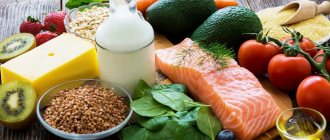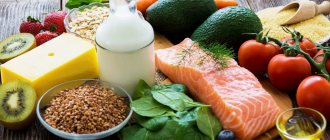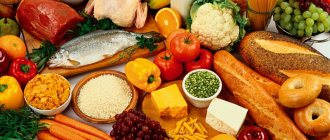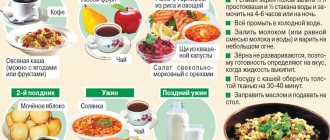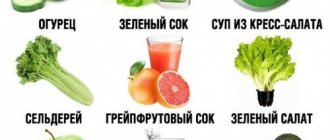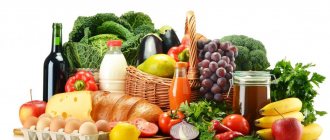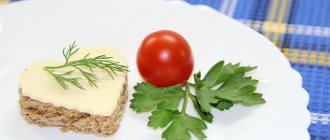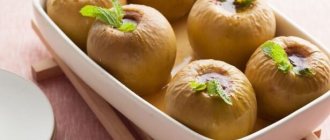Characteristics and symptoms of anemia
Anemia is a condition in which there is a reduced content of red blood cells or hemoglobin in each individual red blood cell, measured per unit volume of blood. Hb levels decrease below the following limits:
- in children from six months to 6 years - 110 g/l;
- for schoolchildren 7-14 years old - 120 g/l;
- for women - 120 g/l;
- for men - 140 g/l
Symptoms of mild to moderate anemia (Hb value not lower than 70 g/l):
- skin - cold, pale, with a yellowish tint;
- spleen - enlarged;
- intestines - change in color of stool;
- muscles - flaccid, weakened;
- eyes - yellow tint;
- nervous system - fatigue, dizziness;
- circulatory system - low blood pressure;
- respiratory system - shortness of breath, feeling of lack of air;
- heartbeat - rapid.
Symptoms of anemia.
With severe anemia (hemoglobin below 70 g/l), fainting, heart attacks, and chest pain are possible.
Against the background of reduced immunity, the risk of acute respiratory viral infections and tonsillitis increases.
Diagnosis of anemia and treatment features
In old age, the lower limit of normal hemoglobin level is 110 g/l. A decrease in indicators indicates a mild degree of anemia. If hemoglobin drops to 70-89 g/l, we are talking about moderate severity of the disease. In severe pathology, levels are below 70 g/l. The disease can be diagnosed using a simple blood test.
When prescribing treatment, the doctor takes into account not only research data, but also the patient’s age, his condition, the presence of chronic diseases and other characteristics. At the initial stage, when the indicators are not critical, iron deficiency can be corrected with a special diet. Vitamins, dietary supplements, and a balanced diet for anemia in old age can prevent a lack of beneficial microelements and help improve the patient’s condition.
When it comes to the moderate and severe stages of anemia, diet is no longer enough. Specialized drugs are needed to promote the active formation of hemoglobin and red blood cells in the cells. Medicines are taken according to the regimen prescribed by the doctor. As a rule, during meals: this way, nutrients are better absorbed by the body. Some drugs have side effects: nausea, constipation, abdominal pain. The average duration of treatment is 3-5 months. If necessary, in addition to tablets, intramuscular or intravenous injections are prescribed.
If hemoglobin levels are critical, the question of a blood transfusion may arise. This decision is usually made by a council of doctors.
Causes of the disease
Iron deficiency anemia develops for the following reasons:
- Processes in the gastrointestinal tract in which the function of iron absorption is impaired.
- Donation, blood loss after surgery, trauma.
- Siderosis (lung damage that develops when working with metal dust or shavings).
- Hormonal disorders, taking corrective medications.
- Chronic conditions associated with blood loss (enteritis, ulcerative colitis, uterine fibroids, peptic ulcer).
- Fasting, vegetarianism.
Iron deficiency anemia: causes and signs
The causes of blood iron deficiency lead to relative and absolute deficiency of this microelement. Etiological factors:
- Losses due to bleeding (trauma, menstruation);
- Insufficient absorption in intestinal diseases;
- Liver pathology with impaired production of transport proteins (ferritin, transferrin).
Bleeding in the gastrointestinal tract occurs against the background of erosive or ulcerative processes in the stomach, small and large intestines. Tumor diseases and varicose veins lead to hemorrhages less often. Impaired iron absorption occurs during intestinal resection, chronic colitis, and proliferation of hemorrhoidal veins of the rectum. Causes of relative iron deficiency:
- Intensive growth;
- Pregnancy;
- Sports activities;
- Lactation;
- Insufficient food intake;
- Vegetarian diet.
The average daily dose of this microelement for women is 15 mg, and for men – 12 mg. During pregnancy, the need doubles. The first symptoms of anemia of the prelatent stage:
- Malaise;
- Decreased performance;
- Weakness;
- Perversion of taste;
- Dry hair;
- Burning sensation in the vagina in women;
- Brittle nails;
- Atrophy of the tongue papillae.
Clinical signs of the pathology include fatigue, headache, drowsiness, and frequent fainting. The severity of symptoms depends on the hemoglobin concentration and the age of the patients.
Getting rid of cigarette addiction is extremely difficult: it includes both physical and psychological components. Nicotine is integrated into metabolism, so long-term smokers face serious stress when quitting. Read more in the article: “changes in the body after quitting smoking.”
The need to follow a diet
The purpose of therapeutic nutrition for anemia is to provide the body with the necessary amount of nutrients, vitamins, and nutrients. The diet contains enough iron required for Hb growth. It improves the quality of life, restores strength and strengthens the body's protective functions.
It is necessary to follow a diet to provide the body with the necessary substances.
The essence of diet 11 according to Pevzner
The therapeutic diet was developed by the Soviet nutritionist M.I. Pevzner in the 1920s. The system is aimed at individual therapeutic nutrition for various diseases. The complex consists of fifteen treatment tables, each of which corresponds to a specific problem. Patients are recommended to follow a diet for some time after discharge from a medical facility. Diet 11 is prescribed during the period:
- tuberculous disease of the lungs and bones;
- inflammation of the lymph nodes;
- weight loss;
- postoperative exhaustion associated with trauma;
- infectious disease.
The diet is characterized by increased energy value with a high content of protein, vitamins and minerals. It provides five meals a day. The compliance time is one to two months. The food system is used in sanatoriums, hospitals, and children's health camps. Smoking and drinking alcoholic beverages are prohibited during use.
Every day the patient needs to gain up to 3500 kcal from protein and plant foods. During the season, fresh vegetables, fruits, and herbs should be consumed to fill the body with vitamins. There are no restrictions on the thermal processing of food. Fried foods are allowed on the daily menu in small quantities. The temperature of the dishes is maintained at 65 degrees.
For a patient suffering from tuberculosis, natural cow and goat milk is included in the diet. The products contain calcium and animal fats, which are necessary for the body during the recovery period.
The norm for taking dairy products for anemia is determined by the attending physician. Fermented milk products prevent the complete absorption of iron, which is necessary for a sick person.
Principles of diet planning
When developing a menu for people who suffer from IDA, adhere to the following rules:
- An increased amount of protein in the menu promotes good absorption of iron. The proportion of carbohydrates does not change, but fats decrease slightly.
- Inclusion of broths and soups in the menu. They stimulate gastric secretions and promote proper absorption of nutrients.
- Taking ferruginous mineral waters - “Darasun”, “Kuka”, “Polyustrovskaya”, etc. Drinking juices from pomegranate seeds, apples, grapefruit.
Authorized Products
The correct diet for anemia is based on the following products:
Lamb is an approved product.
- lamb, veal;
- beef and pork offal;
- seafood and sea fish;
- buckwheat, oatmeal, millet, barley groats;
- wholemeal bread;
- beets, tomatoes, eggplants, zucchini;
- dill, green onions;
- red and black berries;
- low-fat fermented milk products;
- dark varieties of honey, bee bread, pollen;
- sunflower seeds, pumpkin;
- quinces, plums, peaches.
Sufficient amounts of vitamin C and folic acid promote better absorption of iron from food. To get them into the body, it is recommended to consume sea buckthorn, black currants, citrus fruits, and nuts. Milk and honey will help compensate for the lack of vitamin B12.
Prohibited Products
You should limit foods and drinks rich in calcium as much as possible: parsley, milk, chocolate, coffee, tea. Until your hemoglobin level normalizes, you should not frequently consume spinach, asparagus, rhubarb, and bran.
Coffee and chocolate should not be consumed if you are anemic.
Sources of iron
Leaders in iron content:
- Liver and red meat. 100 g of product contains 35% of the daily requirement of iron in heme form.
- Mussels. From 100 g of seafood you can get 13% of the daily requirement of a microelement.
- Quinoa. Inca cereal does not contain gluten, so it can be used in the diet of people suffering from celiac disease.
- Black beans. Includes maximum amounts of non-heme iron.
- Sugar cane molasses. In 1 tsp. The product contains almost 1 mg of iron.
How to increase low hemoglobin
To quickly restore Hb, you should consume:
- lean red meat and liver;
- red caviar;
- buckwheat porridge;
- pomegranate juice;
- honey with chopped dried apricots and nuts.
To increase low hemoglobin, you need to drink pomegranate juice.
Foods that interfere with iron absorption
To effectively correct the condition of IDA, exclude from the menu foods that contain oxalates that interfere with the absorption of iron:
- lard, margarine, bacon;
- smoked meats, fatty meats;
- brines, marinades;
- buns, pies;
- tea, coffee, lemonades;
- black grapes;
- green tea;
- artichoke;
- strong alcoholic drinks.
Fat interferes with iron absorption.
What foods and vitamins are useful in the treatment and prevention of anemia?
Basic principles of menu planning for iron deficiency anemia:
- calorie control;
- reducing the proportion of fats and carbohydrates;
- maintaining the balance of iron and vitamins.
The first rule: the diet must contain foods rich in proteins, as they contribute to better absorption of iron. Fats and carbohydrates are “useless” for patients with anemia; their proportions in the diet should not exceed the norm. There are no serious restrictions, but a reasonable approach is welcome. For example, sugar should be replaced with honey, and desserts made from berries and fruits should be preferred over baked goods.
Another rule that patients with anemia must adhere to: do not neglect liquid meals. Soups, broths, sauces stimulate the secretion of the stomach, which promotes better absorption of nutrients.
The third rule concerns fluid intake. It is best to drink ferruginous mineral waters, carbonated or still. But it is better to exclude sweet soda from the menu, replacing it with rosehip decoction or dried fruit compote. Juices from pomegranate, cranberries, apples, and citrus fruits are beneficial.
The correct diet for anemia is a set of dishes made from foods rich in protein and iron:
- liver and meat of rabbit, turkey, chicken;
- lamb, veal;
- eggs;
- buckwheat, oatmeal, millet, barley;
- sea fish and seafood;
- berries (blueberries, raspberries, gooseberries, strawberries, grapes);
- fruits (apples, peaches, plums, bananas, quince)
- wholemeal bread;
- greens and vegetables (beets, carrots, tomatoes, zucchini).
Nutritionists recommend combining protein foods and “vitamin” foods: the therapeutic effect with such nutrition is achieved faster. To maintain vitamin balance, patients with anemia should regularly consume:
- berries and fruits rich in vitamin C (sea buckthorn, black currants, citrus fruits, apricots, strawberries);
- milk with honey to restore vitamin B12 (cobalamin) in the body;
- nuts (almonds, peanuts), citrus fruits, greens and other foods containing folic acid.
Treatment table No. 11 for anemia
Diet No. 11 according to Pevzner is enriched with proteins, vitamins, and amino acids. It contains a sufficient amount of iron, folic acid, vitamins C and B12. The menu involves the use of foods that are involved in hematopoiesis and affect the absorption of iron. The total daily weight of products is about 3 kg, and the calorie content is 2900-3500 kcal.
Almost all foods are allowed for consumption, with the exception of some fats.
Chemical composition of the daily diet
The daily menu of the “Table No. 11” diet is based on the following principles:
- Protein content - 110-130 g. A large proportion of proteins (60%) comes from animal products.
- Amount of carbohydrates - 400-450 g.
- Fat consumption - 100-110 g. It is not allowed to consume cooking fats, lard, meat with a high content of refractory fats (duck, lamb).
It is not allowed to eat meat with a high content of refractory fats.
Rules for eating
The daily intake of products is usually divided into 4-6 doses.
Fractional nutrition promotes better absorption of vitamins and microelements, helps the body to normally perceive the high calorie content of the diet. The food temperature can be in the range from 15 to 40. During food preparation, all types of heat treatment are allowed, except for frying and smoking.
A prerequisite is to drink enough fluid (about 2.5 liters per day).
Allowed and prohibited foods on diet 11
The products used are divided into those that are suitable and those that are not suitable for a particular disease. In diet 11 according to Pevzner, there is no concept of harmful and healthy foods.
The list of eligible ones includes:
- all types of meat, as well as fish with a low percentage of fat, chicken. High-quality sausages and frankfurters, beef liver, canned products;
- oatmeal, buckwheat, pasta, beans;
- dishes made from fruits and berries, fresh or baked;
- unlimited number of eggs (chicken or quail);
- greens and vegetable products;
- first course (cream soup, cabbage soup, borscht);
- jams, preserves, honey, baked goods;
- milk, cottage cheese, sour cream, kefir, butter;
- juices, dried fruits, rosehip decoction.
- nuts (hazelnuts, walnuts, peanuts), flax and sesame seeds.
In diet number 11, the following are considered inappropriate:
- spicy-tasting sauce and seasoning, table vinegar, mustard, pepper;
- all types of meat with high fat content;
- creamy pastries;
- margarine product, fat (from pork, lamb, beef, culinary);
- processed cheese, coffee, sweet lemonade with gas;
- low quality sausages.
Diet table 11 provides for limited consumption of salt and sugar. For sweetness, natural honey or maple syrup is added to dessert products. Instead of salt, the taste of the dish is enhanced by the addition of basil, cilantro, and rosemary.
In the first half of the day, it is desirable to have a predominance of carbohydrates in the diet, and at dinner - more protein and plant foods. Add fruit for breakfast, and make up an afternoon snack menu of vegetables and dairy drinks. To dress salads, use sour cream, olive oil, and lemon juice. First courses (meat and vegetable broth, puree soup) are a must in the daily menu.
A specific menu with a set of products useful for the patient will be drawn up by the attending physician, taking into account the existing disease, severity and stage of recovery. Changing your diet on your own is not recommended. Therapeutic nutrition on diet 11 is easily accepted by patients during recovery.
Dietary rules for various types of anemia
The menu is developed by a nutritionist or hematologist, adjusting the menu depending on the type of anemia. For pathologies caused by iron deficiency, the menu includes foods high in vitamin C and Fe. If Hb is low due to a lack of vitamin B12, select foods that contain a lot of it (sardines, Atlantic mackerel, feta, salmon, lamb, cottage cheese, eggs).
For iron deficiency anemia
Fats interfere with the normal absorption of iron from food, so their daily intake is reduced to 80-90 g. Refractory fats are completely excluded. They are found in butter, lamb, duck, cream, cheese and curd products. Protein consumption is increased to 140 g.
For iron deficiency anemia, increase protein intake.
Calcium forms insoluble compounds with ferrum, which prevents its absorption. This can be avoided by timing the intake of calcium- and iron-rich foods. The menu includes foods rich in vitamin C.
For B12 deficiency anemia
If there is a lack of cyanocobalamin and the resulting changes in the biochemical composition of the blood, diet No. 11 is also prescribed. The emphasis is on dishes made from beef liver, kidneys, heart, fish and seafood. Additionally, they include foods containing folic acid, which promotes the absorption of vitamin B12.
These are asparagus, citrus fruits, nuts, watermelons, tomatoes, grain bread, avocados, cereals, cod liver.
For hemolytic anemia
With this form of pathology, the diet includes foods that contain substances to support the process of hematopoiesis. Adhering to the basic principles of diet No. 11, increase the proportion of the following components:
- Currants, milk, and rose hips will help compensate for the lack of cobalt.
- The source of manganese is greens.
- Zinc is found in mushrooms, cheese, and yeast.
- The lack of copper will be compensated by legumes: cereals, mushrooms.
For hemolytic anemia, you need to eat cheese and mushrooms.
For aplastic anemia
In case of pathology, it is necessary to support the process of hematopoiesis. The basis of the diet is table No. 11, including in the diet foods with a large proportion of cobalt, manganese, copper and zinc.
Principles of nutrition
Iron is absorbed better and faster through the digestive organs, which cannot be said about drug injections. Nutrition comes first in the treatment of anemia. This normalizes the concentration of red blood cells.
When the disease develops, it is recommended to create a diet so that it contains a lot of protein. It increases the absorption of iron, the formation of hemoglobin and red blood cells begins.
It is recommended to avoid fat-containing foods completely or reduce consumption to a minimum.
According to statistics, left-sided pain in the lower abdomen bothers every 6th person on the planet at least once in their life. There are many known diseases that are characterized by the presence of this symptom. Read more in the article: “the left side of the lower abdomen hurts in women.”
Eating right is not enough; food must be prepared properly.
Principles of creating a dietary menu
Proper nutrition is aimed at replenishing the supply of nutrients and microelements. Basic principles of diet for iron deficiency anemia:
- increasing protein intake;
- choosing foods high in iron;
- foods with plenty of vitamin C and B vitamins.
Nutritionists recommend treating anemia with proper nutrition. When creating a menu, preference is given to products with minimal fat content. The amount of carbohydrates in the selected dishes does not matter. Adults who want to lose weight should give preference to foods with complex carbohydrates - they should stop using white sugar, replacing it with natural honey.
The diet for anemia should consist of legumes and grains. This food is high in iron. To absorb the maximum amount of microelement, it is necessary to include foods with a high content of vitamin C in your daily menu.
Diet for anemia in children
In infants born from healthy mothers, anemia rarely occurs before the age of 1 year, since the absorption of iron from mother's milk is higher than from other products. If a blood test shows a decrease in Hb levels, a nursing mother should adjust her diet and include iron-rich foods in the menu.
A nursing mother needs to adjust her diet.
For anemia in children from one to 6 years of age, beef pates and offal, apple juices and purees, beets, fresh herbs, and sea fish are introduced into the diet. From the age of 4 you can try honey if you have no allergic reactions to bee products.
The child's diet should include meat, low-fat broths, sesame seeds, wholemeal bread, and cereal porridge. Drinks include apple and pomegranate juices, rosehip decoction with honey. During adolescence, children may consciously refuse meat.
Iron from plant foods is less absorbed, so Hb levels should be regularly monitored.
Anemia
Anemia must be treated. The question is what methods to choose to treat the development of anemia so that they are as effective as possible. Our medical center specialists will select an individual program for you and prescribe the necessary medications. Anemia can be easily eliminated if you follow the main rules and principles of getting rid of pathology.
The main principles of treating anemia disease
The principles of treating anemia disease are as follows:
- iron deficiency type is eliminated by using components containing iron;
- if there is a lack of B12, this drug is prescribed, sometimes it is administered by injection;
- in children, anemia is often caused by parasites, then a specialist prescribes antiparasitic drugs;
- pregnant women are allowed to use folic acid and some preparations containing iron;
- An important principle is the combination of medicinal effects and nutrition. The analysis showed that it is precisely because of nutrition that pathology such as anemia actively develops.
By following these principles, you can restore your health in a short time. This should only be done under the supervision of an experienced professional. Only a doctor can prescribe medications; it is not safe to take them yourself.
Anemia is not a death sentence: how to improve treatment
To improve health and speed up the healing process, the patient can help himself. You should know that this pathology is not a death sentence. You can quickly get rid of it if you adjust your diet correctly. Here are some tips to help you feel much better:
- The diet should include cream, meat, butter. They contain a large number of amino acids, proteins;
- Green vegetables contain folic acid, greens and salads help well;
- To improve blood formation, it is recommended to eat carrots, beans, peas, fish, liver, oatmeal, and corn. Tomatoes, lentils, apricots are also useful;
- Iron-fortified foods are needed. These are bread, baby food, confectionery;
- To ensure that iron is well absorbed by the body, we recommend eating honey;
- 1 glass of plum juice contains 3 mg of iron. This is an excellent product for increasing the level of this component in the body;
- eating apples, pineapple, strawberries, viburnum will also have a beneficial effect on your health;
- Natural pomegranate juice helps increase hemoglobin levels;
- You should limit yourself in the consumption of baked goods and fats;
- tea and coffee can also have a detrimental effect on health in such pathologies;
- exclude dishes containing vinegar, brine, and alcohol.
- These recommendations will allow you to improve nutrition in case of pathology. The doctor will help you create the right menu, call us and make an appointment.
Is it possible to treat anemia with folk remedies? We treat correctly
Many people are interested in the question of whether anemia can be eliminated with folk remedies. It is worth remembering that this is only a manifestation of other ailments, so you should initially get rid of them. Doctors help eliminate pathology, but also recommend folk remedies.
However, there are a number of restrictions: they can only be used under the supervision of a specialist. Follow the dosage exactly and do not get carried away with herbal medicine. It will not replace a full recovery course. But it will still help relieve a number of unpleasant sensations, reduce signs of pathology, and improve blood circulation. Here are some recommendations:
- You should use an infusion of shepherd's purse three times a day. It is important to prepare the component correctly; your doctor will tell you about this in detail;
- An infusion of stinging nettle helps. It is easy to prepare at home, you should drink half a glass, 2 doses per day;
- Wild strawberries help, both fruits and leaves. Can be used in various ways, even just brew a light decoction in the form of tea;
- spinach and dandelion leaves also improve the functioning of the circulatory system. You can safely add young leaves to the salad, and in a later period make decoctions and drink instead of tea;
- horsetail also helps to cope with this disease.
The doctor will tell you in detail about the use of medicinal components of herbal medicine. Of course, they will not replace the main course, but they can complement it well. But it is allowed to do this only under the supervision of a specialist.
Nutrition for anemia in pregnant women
During pregnancy, the intake of iron into the body of the expectant mother should be increased. Its daily share should cover the needs of the mother and fetus. The diet must include:
- cabbage - white, red, sea cabbage;
- low-fat fish;
- prunes;
- pumpkin seeds;
- lean red meat;
- blueberries, apples;
- dark honey.
You need to include cabbage in your diet.
List of products for the treatment of anemia
When you are suffering from anemia and choosing foods for your diet, it is important to understand which of them will be “friends” and will help increase hemoglobin, and which should be limited in food. Conventionally, all products can be divided into 3 groups: iron-containing, helping the absorption of iron into the body and preventing its absorption.
Products – iron suppliers
Proper nutrition for anemia in older women is a universal remedy for the prevention and treatment of the disease. A correctly selected set of products will effectively increase the amount of iron in the body. Products whose substances are part of hemoglobin include:
- White mushroom,
- beef,
- peas,
- raisin,
- cocoa,
- dried apricots,
- pork liver,
- Brewer's yeast,
- tomato,
- prunes,
- lentils,
- apple,
- egg.
Products – iron absorption enhancers
Along with direct suppliers of iron-containing protein hemoglobin, an important role in nutrition is also played by products that help the absorption of this protein. The anthocyanins they contain significantly increase the absorption of iron in the body. These foods include any types rich in vitamin C, as well as vegetables and fruits that are yellow, orange, red and purple:
- apricot,
- orange,
- beetroot,
- grape,
- cherry,
- pomegranate,
- greenery,
- lemon,
- milk,
- carrot,
- melted butter,
- cherries,
- garlic.
Foods that interfere with iron absorption
In addition to products that are useful for anemia, there are a number of products that inhibit the absorption of iron-containing protein, which slows down the improvement of the blood count and prevents the stabilization of the body. As a rule, these products contain large amounts of phytates, calcium and polyphenols, which form an insoluble complex with iron. The list of products whose consumption should be excluded or limited in case of anemia during pregnancy is as follows:
- alcohol,
- coffee,
- corn,
- nuts,
- wheat,
- pickles and brines,
- soybean,
- tea,
- sorrel.
Menu examples
The diet of people who adhere to the “Table No. 11” diet may contain many meat, lean, vegetarian and vegetable dishes. The large variety of foods available provides all the nutrients to support the body.
For anemia in older women and pregnant women
To build a therapeutic diet, you can follow this plan:
- Morning. Buckwheat porridge, dried fruits, pomegranate juice.
- Lunch. Cranberry juice jelly.
- Dinner. Salad (tomatoes, cucumbers, herbs and soft cheese), red borscht, boiled chicken breast. Berry juice.
- Afternoon snack. Cottage cheese casserole with candied fruits, yogurt without filler.
- Dinner. Stuffed eggplants. Tomato. Rose hip decoction.
- Dream Interpretation. Kefir or yogurt.
For anemia in older women and pregnant women, you should eat buckwheat porridge.
Juices can be alternated by squeezing them from apples, apricots, and peaches. For lunch and dinner you can cook steamed or baked fish and red meat. Honey, which should be consumed with tea, will bring benefits. The norm is 1 tsp. per day in the absence of diabetes and allergies to bee products.
For a week for children
Parents can prepare food for the child separately or eat according to the proposed menu with the whole family. An example menu is presented in the table:
| Day of the week | Breakfast | Lunch | Dinner | Afternoon snack | Dinner | Dream Interpretation |
| Mon | Oatmeal with dried fruits, bread, apple compote | Orange | Pea soup with wheat croutons, baked sea bass fillet. Biscuits, cranberry juice | Cottage cheese casserole, apple juice | Mashed potatoes, beef cutlet, vegetable salad | Yogurt |
| VT | Buckwheat porridge with milk, sandwich with cheese, rosehip infusion | Banana | Cream of mushroom soup. Beef meatballs, buckwheat porridge, cabbage salad. Bread. Raspberry fruit drink | Pomegranate | Grated carrot salad with vegetable oil. Spaghetti with seafood | Rosehip infusion, biscuit |
| SR | Cheesecakes with sour cream and raisins, birch sap | Kiwi | Vegetable soup, tomato, beef liver pate, millet porridge | Cranberry jelly | Lentil puree, veal meatballs. Vegetable salad | Cocktail made from half a banana and milk |
| Thu | Muesli with dried fruits and nuts. Sea buckthorn infusion | Fruit salad of 1 apple, half a kiwi and an orange | Lentil soup. Bread. Spaghetti with stewed beef liver. Apple juice | Oatmeal cookies, berry juice or compote | Vegetable stew. Baked rabbit (fillet). Rose hip drink | Yogurt |
| PT | Nalistniki with beef liver. Rose hip drink | Green apple | Cream of broccoli soup. Bread, stewed potatoes with beef | Plums | Cucumber and tomato salad. Chicken souffle. Currant compote | Yogurt |
| SB | Sandwiches with cheese or boiled beef. Strawberry compote | Buckwheat bread | Ear. Bread. Mashed potatoes, fresh vegetable salad. Tomato juice | Apricots | Fish cutlets, baked cauliflower. Rose hip decoction | Milkshake |
| Sun | Pumpkin porridge in milk with dried apricots. Dried fruits compote | Some walnuts, peach | Buckwheat soup. Bread. Liver pancakes with potatoes. Berry juice | Grapefruit, oatmeal cookies | Chicken meatballs, pea puree. Cabbage salad. Rose hip decoction | Raspberry juice, blackcurrant jelly |
Order this menu:
Individual nutrition (Personal diet) from Performance Food
Rating: no ratings / 1 day: 3700 rubles
…
Order p-food.ru
Recommendations for preparing a diet
How to properly create a menu for a patient with anemia in order to get maximum benefit and enjoy the taste? Nutritionists advise dividing the daily diet into 5 meals. To build a daily menu, use our tips:
- breakfast cannot be skipped. Please yourself and your family with crumbly buckwheat porridge, chicken liver, and vegetable salads. Cranberry juice or berry compote are perfect drinks;
- For a snack at the office, take apples, nuts, dried fruits or a boiled egg;
- For lunch, prepare soup or broth and a meat dish: chicken fillet with vegetables, stewed lamb, boiled veal. Dessert can be fruit salad;
- low-fat cottage cheese with honey is an excellent option for a light afternoon snack;
- dinner should be low-calorie and healthy. We recommend baked fish; this dish will perfectly complement a salad of fresh tomatoes and herbs.
When creating a menu for every day, control the ratio of proteins, fats and carbohydrates. Combine dishes in such a way that the body is guaranteed to receive iron, folic acid, vitamins C, B. When forming a diet with a predominance of protein foods, do not forget about fiber: cabbage, celery, carrots, beets, tomatoes, greens will help the functioning of the gastrointestinal tract, cleanse body and ensure excellent absorption of nutrients.
Diet recipes
When compiling a diet, you should be guided by the list of permitted and prohibited foods.
Chicken and vegetable salad
Take 300 g of chicken fillet, 2 cucumbers and tomatoes, lettuce, green onions, olive oil - 2 tbsp. l. Wash and dry the breast, cut into pieces 2 cm thick. Fry in oil until golden brown. Cut cucumbers into slices, tomatoes into slices. Place lettuce leaves, vegetables and cooled meat on a plate. Season and sprinkle with green onions.
Chicken and vegetable salad has a very rich, pleasant taste.
Roast beef
Cut the peeled potatoes (500 g) into cubes, chop the onion, grate the carrots. Fry the onion until golden brown, add the carrots and simmer for about 4 minutes. Place the potatoes in a clay pot or glass baking tray. Add vegetable gravy to it. Cut the washed and dried beef (500 g) into small pieces. Send to vegetables, add salt and fill with hot water to the top. Bake in an oven preheated to 180°C for 45 minutes.
Cod in sour cream sauce
Cut the defrosted cod fillet (600 g) into pieces. Salt, pepper, roll in flour and fry in sunflower oil. Place on a napkin to absorb excess fat. Cut the onion into half rings and fry in the pan where the cod was cooked. Place the fish on the onion bed. Dissolve 5 tbsp in a bowl. l. sour cream, 400 ml water, 1 tbsp. l. flour. Add some salt and turmeric. Stir the sauce until smooth and pour it over the fish and onions. Cover with a lid and simmer over low heat for 10 minutes from the moment it boils.
Cod in sour cream sauce is a very tasty, tender dish.
Spaghetti with meatballs in tomato sauce
Prepare equal amounts of spaghetti and ground beef (300 g each), raw egg, onion, tomato paste and vegetable oil (3 tbsp each).
Before cooking, grate the onion. Add it along with the egg to the minced meat, salt and season to taste. Form meatballs and fry in a frying pan until golden brown. Dilute tomato paste in a glass of warm water, adding a pinch of sugar and salt. Place the meat balls in a saucepan, add the prepared tomato liquid and simmer for about 25 minutes over low heat. Boil the spaghetti and transfer to a dish. Place the meatballs and pour over the tomato sauce.
Oatmeal with dried fruits
Prepare 200 g of oatmeal, peeled and chopped apple, a handful of raisins, honey, cinnamon and butter. Pour boiling water over the washed raisins and leave for 5 minutes. Place oatmeal in a saucepan, add raisins and add water (2 cups). Bring to a boil, reduce heat and cook the porridge for about 10 minutes, stirring. Season with butter and place on a plate. Garnish with apple and sprinkle with cinnamon.
Oatmeal has a beneficial effect on digestion.
Stuffed eggplants
Pour 1 tsp of water overnight. sunflower seeds. In the morning, drain the water and dry the grains. Cut young eggplants (3 pieces) lengthwise, scoop out the pulp with a spoon and sprinkle it with salt. Leave for 10 minutes. Finely chop the pulp, sprinkle with chopped onion (1 piece) and simmer. After blanching, peel the tomatoes (4 pcs.) and cut into large cubes. Add tomatoes to eggplant pulp and onions, sprinkle with chopped herbs (except mint and basil). Simmer for 10 minutes. Remove from heat, add crumbled cheese (150 g) and seeds.
Fill eggplant boats with the mixture and place them on a greased baking sheet.
Bake in the oven at 180°C for 45 minutes. Serve sprinkled with mint and basil.
Iron-containing menu for anemia
Fortunately, the healthy foods needed for anemia are available all year round. From these you can easily create a treatment menu for several days. We offer an approximate menu for anemia in pregnant or elderly women.
Option 1
Breakfast:
2 soft-boiled eggs + cabbage salad + black bread toast with butter and hard cheese + a glass of orange juice
Lunch:
cottage cheese mousse with dried apricots and prunes + apple juice
Dinner:
chicken soup + stewed liver with onions + vegetable or fruit salad + fruit compote
Dinner:
fish baked in foil + stewed carrots + herbal tea
Option 2
Breakfast:
2 egg omelette + carrot salad with garlic + black bread toast with butter and hard cheese + glass of apple juice
Lunch:
oatmeal with dried fruits + rosehip decoction
Dinner:
borscht with porcini mushrooms + baked turkey with vegetable stew + vegetable or fruit salad + fruit compote
Dinner:
beef meatballs + pea puree + herbal tea
Option 3
Breakfast:
buckwheat porridge + chicken liver + vegetable salad + cranberry juice
Lunch:
boiled egg + apple + nuts
Dinner:
vegetable soup + lamb stew + fruit salad + fruit compote
Afternoon snack:
cottage cheese with honey
Dinner:
baked fish + tomato and herb salad + green tea
Option 4
Breakfast:
fried liver + mashed potatoes + herbal tea
Lunch:
apple + hard cheese
Dinner:
borscht + boiled chicken + baked vegetables + compote
Afternoon snack:
butter bun + rosehip decoction
Dinner:
oatmeal with milk + cottage cheese
Before bedtime:
curdled milk
Option 5
Breakfast:
vegetable salad + oatmeal + milk
Lunch:
fresh fruits
Dinner:
cabbage soup + boiled rice + boiled beef + berry compote
Afternoon snack:
Herb tea
Dinner:
stewed vegetables + boiled chicken + rosehip broth
Before bedtime:
kefir
When drawing up a menu, it should be taken into account that nutrition for anemia in pregnant women and the elderly should be aimed at solving two problems - saturating the body with oxygen and eliminating iron deficiency. To do this, you should maintain split five meals a day and adhere to a balanced diet rich in iron, proteins and acids to stimulate the process of blood formation.
Duration of diet for anemia
The restoration of iron levels in the body of children and adults occurs gradually, so nutrition to increase hemoglobin is designed for a long period. Once a month, the patient donates blood, which allows the doctor to judge the effectiveness of therapy and adjust the treatment program.
Dietary food is designed for a long term.
The principles of the “Table No. 11” diet for anemia should be followed for at least 3 months. When the level of Hb in the blood is normalized, it is canceled, however, when creating a diet, it is recommended to rely on the acquired eating habits.
Peculiarities
One of the main conditions for the name of this diet is the absence of problems with the gastrointestinal tract.
The diet is high in calories - the patient consumes about 3000–3500 kcal per day. Calorie intake increases due to increased consumption of protein and fortified foods; the amount of carbohydrates and fats also increases, but within moderate limits.
Additional minerals and vitamins are introduced into the diet, and the daily calcium intake is increased.
Article on the topic
The power of blood. What should you eat to maintain your hemoglobin level? There are no special requirements for heat treatment of food, but you need to eat at least 5 times a day. It is recommended to drink as with a normal diet - at least 1.5 liters per day.
Traditional medicine recipes to combat anemia
Beetroot and carrot juice with honey.
You should squeeze juice from fresh beets (50 ml) and carrots (100 ml). Mix the liquids and add 1 tbsp. l. liquid honey. Use daily in the morning for 2 weeks. Vitamin drink. Extract juice from apples, pomegranate seeds, grapes, carrots and beets. Mix in equal proportions and drink immediately. You can sweeten the drink with fructose. The duration of the course of treatment is 2-3 weeks.
Product based on buckwheat and nuts. Grind 1 cup walnut kernels and 0.5 cup buckwheat to flour. Add 100 ml of light honey and stir. Use the mixture before meals 3 times a day, 1 tsp. The course of treatment is 2 weeks. You can repeat it in a month.
Consequences of not following the diet
By ignoring the recommendations of nutritionists, people with anemia can harm the body. Iron deficiency leads to chronic hypoxia of tissues and organs. Gradually, atrophy of the mucous membranes of the respiratory and digestive systems occurs. If anemia is left untreated, myodystrophy develops. Lack of Hb provokes the development of vascular and heart diseases, and leads to a decrease in immunity. The body becomes vulnerable to infections, there is constant weakness and drowsiness.
If the diet is not followed, there is constant weakness and drowsiness.
Anemia. Five frequently asked questions
We answer frequently asked questions about anemia together with family doctor, GMS Clinic therapist, Fedor Mikhnevich.
Doctor, I am constantly tired, I feel dizzy and have a headache, my hair is falling out, I don’t have enough strength for work and family, what could it be?
Your symptoms may be signs of both an underactive thyroid gland and anemia. If at the same time you do not have enough air during exercise, if there are problems with memory, then most likely we are talking about anemia.
What tests do I need to take right now?
Anemia can be diagnosed by a complete blood count. If the analysis shows a decrease in hemoglobin, a decrease in the number of red blood cells and a decrease in their average size, then anemia is confirmed. Such blood carries oxygen worse, all tissues and organs suffer, which causes such symptoms.
If a decrease in hemoglobin and the average size of red blood cells is detected, then iron deficiency anemia comes first, which accounts for approximately half of the cases of all anemia and is the most common nutritional disorder of all. To confirm, tests are done for ferritin, TLC, serum iron, transferrin saturation, as well as an analysis for vitamin B12 and folic acid.
Why did I get anemia? Is she being treated?
In a young woman, the most common causes of iron deficiency are heavy menstruation, pregnancy, lactation, and vegetarianism. In children, anemia is associated with an excess of the need for iron over its intake from food. In the elderly - deterioration of iron absorption. It is much more serious if such anemia is detected in a man or woman over 50 years of age, in which case it is first necessary to exclude an oncological process in the gastrointestinal tract, where blood loss is invisible. And for iron deficiency, it is enough to lose a tablespoon of blood per day.
There are other causes of anemia that are less common: genetic, toxic, infectious. Anemia, of course, can be treated. There are iron supplements that are taken in tablets or administered intravenously. With proper treatment, hemoglobin begins to rise after 3-4 weeks, and complaints disappear after one and a half to two months. And only after 3 months iron reserves are restored in sufficient quantities.
Is it possible to prevent anemia?
To prevent anemia, every person is able to monitor their diet so that it is balanced and includes foods rich in iron: spinach, broccoli, apples, currants, turkey meat, liver, red fish, buckwheat, millet, protein and always a source of vitamin C, which is necessary for the absorption of iron.
What other recommendations can you give to avoid it?
A timely visit to a doctor will help to avoid anemia, for example, in connection with frequent nosebleeds, and for women - to a gynecologist. Also, eliminating foci of chronic infections will help avoid anemia.
Comments from nutritionists
Lyudmila Smirnova, Professor, Head of the Department of Clinical Hematology and Transfusiology BelMAPO, Minsk: “The main source of iron for the human body is meat and fish.
The microelement is practically not absorbed from plant foods, so you cannot limit yourself to its consumption if it is necessary to increase hemoglobin. You should not combine fermented milk products and animal proteins, since calcium interferes with the absorption of iron.” Svetlana Fus, nutritionist, Kyiv: “If the diet does not give results, you should evaluate the food diary to understand whether there are competing products in one meal. For example, calcium/iron. With low acidity of gastric juice, iron is poorly absorbed from food. To check the condition of the gastrointestinal tract, you should contact a gastroenterologist.”
Vera Kodentsova, professor, leading researcher at the Institute of Nutrition of the Russian Academy of Medical Sciences, Moscow: “Products No. 1 for iron deficiency anemia are beef liver and red meat. They contain B vitamins and iron in heme form, which is easily absorbed. Beef should be present in the diet every day, liver - 3 times a week.”
Diet for iron deficiency anemia
“Iron” people: diet for iron deficiency anemia
Lack of iron can lead to anemia. With the help of a specially selected diet, this problem is solved in most cases within 3 months.
therapeutic diets, iron deficiency anemia
Iron is a vital microelement involved in oxygen metabolism and hematopoiesis. It is part of hemoglobin, which is responsible for transporting oxygen through the bloodstream. The syndrome of decreased hemoglobin concentration and decreased number of red blood cells in the blood, caused by a lack of iron in the body, is called iron deficiency anemia (anemia). To prevent and correct this condition, it is necessary to consume iron-rich foods, as well as vitamins that improve iron absorption.
Reviews and results
Ivan, 42 years old, Yaroslavl: “After abdominal surgery, it took a long time to recover and ate sparingly.
As a result, hemoglobin dropped below 80 g/l. The doctor prescribed multivitamins, a preparation containing iron, and recommended table No. 11. I have been restoring hemoglobin for the third month, it has risen to 100 g/l. The menu includes pomegranate juice, honey with nuts and dried apricots, salmon caviar, meat pates, baked vegetables. However, it’s too early to talk about victory over anemia; you feel weak and drowsy.” Elizaveta, 29 years old, Yekaterinburg: “Because of uterine fibroids, I suffer from heavy and prolonged bleeding. Hemoglobin rarely rises above 100 g/l. The doctor knows about this, but does not refer her for myomectomy. I constantly have to keep table No. 11 and take courses of iron supplements. Red caviar, beef, and liver pate restore blood well. Since there is no time to cook during the week, the diet contains only salads and meat. For some this is meager, but I’m used to it.”
Nadezhda, 55 years old, Sretensk: “My granddaughter, a student, lives in a dormitory in Chita. Despite my support, he saves money and eats from hand to mouth, but still works part-time. It ended in a hungry faint. We went to the doctor, where it turned out that the girl’s hemoglobin was 75 g/l. She stayed with me for two weeks while on sick leave. I fed her dietary meat, cooked fruit drinks, made juices and porridge. My granddaughter felt better and returned to school.”
Table No. 11 - nutritional features
The main differences between the diet and many others are the large list of allowed foods and the high daily calorie intake - from 3000 to 3500. You should not consume more than 3500 kcal, this can lead to excess weight gain and the body will definitely not thank you for it.
All food should be divided into 5 meals - 3 main meals and 2 snacks. It is necessary to drink a sufficient amount of clean water without gas. The total calorie content of the diet increases due to foods rich in proteins, the amount of carbohydrates and fats increases slightly. That is, do not expect that on diet No. 11 you can eat all the harmful things that you previously forbade yourself. As in any similar nutritional system, the emphasis is on food rich in vitamins, minerals, and amino acids, which the body so badly needs during the period of recovery from illness and during weight loss.
The BZHU balance should be as follows:
- proteins - 100-120 g;
- fats - 90-110 g;
- carbohydrates - 400-450 gr.
In this case, 50-60% of proteins should be of animal origin, 25-30% of fats should be of vegetable origin. This ratio can be changed by the attending physician according to indications.
